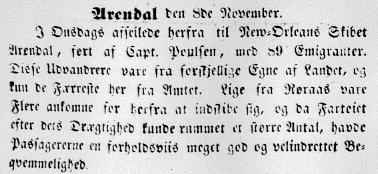The bark Arendal was built in 1847 in Arendal. She belonged to Christian Stephansen of Arendal. Her tonnage was 206,5 Norwegian Commercial lasts. This ship also rounded Cape Horn and sailed to California. The Arendal sailed with emigrants from Norway in 1851 and 1854. In 1851 to New Orleans, and in 1854 to Quebec.
"Passenger accommodation from Arendal directly to New Orleans. As soon as the "Arendal" returns from London, she will leave with passengers in the end of October directly to New Orleans. As there is still space, emigrants are requested to give notice written or oral to the undersigned. The ship "Arendal" is a good sailor, and offers good accommodation for passengers. It is copper hooded and in all ways a solid ship, and I feel safe to recommend her. She is classed A-1 in the Lloyd's register of shipping. Arendal September 23rd 1851, Christian Stephansen".

Newspaper notice from "Den Vestlandske Tidende" Nov. 8th 1851: Arendal November 8th. Wednesday the ship "Arendal", Capt. Paulsen departed from here for New Orleans with 89 emigrants. The emigrants were from different parts of the country, and only a lesser part from around here. Even from Røros people had arrived here to enroll for the passage. The ship could due to its tonnage have taken a larger amount of passengers, so those traveling on her will have a good accommodation.
The following is a translation of a voyage account written by Johan Olsen Brunstad.
The ship left Arendal on November 5th at 8 o'clock in the morning. The same afternoon the passengers saw the last of their homeland disappear under the horizon. With favorable wind they crossed the North Sea and entered the British channel after two and a half days. Favorable wind brought them through the channel and the 10th day they were off Madeira. At this stage many of the emigrants was suffering from seasickness. Brunstads wife and two of his children were sick for two days, but not as seriously as many of the other passengers. The temperature was very high all the time during the Atlantic crossing, in particular before they reached the Vest Indies, when the thermometer had shown 30 degrees [Celsius], but the evenings were calm. When the weather was good, the atmosphere had been joyful with song, music and dancing. They also had different Christmas games that would last in to the late hours. When the seasickness was over they had no more sickness on board, and there were no deaths during the journey.
After 3 weeks at sea a child was born by a woman from Tyldalen. The child managed fine and was increasing it's weight. During the crossing they had observed a few other ships, that had all left behind, as non of them could put up with the speed of the "Arendal". They also observed several big fishes, but not much more for at least 5 weeks, but water and sky. On December they could se the coast of St. Domingo at their left, and it had made the passengers happy to see land, after such a long time without the possibility.
On December 13th they could se the coast of Cuba at their right, and sailed along the Cuban coast for 3 days, when they entered the Mexican Gulf. On December 21st they saw the American coast, after having had the pilot onboard 40 miles off the coast. All of the passengers were very happy, and thanked the Lord for his safe guidance on their voyage across the Atlantic. Not a single storm had occurred, and none had been seriously ill.
When we arrived in the Mississippi delta, a huge steamship met them and towed them up the river along
with 3 other ships to New Orleans. When they had their Christmas eve dinner they were 75 miles
from New Orleans, and it was a very nice evening for the passengers. They talked about their
homeland and their relatives and friends back home. In the morning of December 25th, just after sunrise
they first got the sight of New Orleans. At 9 o'clock the anchor was dropped, and the passengers could set their feet on American soil for the first time. They thought the city was huge, and that there was a lot of
movement there. Brunstad says that in the harbor there were thousands of big ships, and among them 5 - 600 steamships. Some of them had an enormous size. On December 27th they left the ship, and took farewell with Captain Paulsen and 2. Mate Karl Hagerman, which had become a personal friend of Brunstad and his family during the voyage.
The passengers now traveled by steamship to Alexandria in Red-River, and from there on a smaller ship to Shreveport where they arrived in January 3rd 1852. They suffered from bad treatment by the sailors and other passengers on this last stage. But there were allot of struggles still ahead.
The account was published in in an article by Kåre Sveen in "Gammelt frå Stange og Romedal" 1975, issued by Stange Historielag
In 1854 she departed from Arendal c. Apr. 15 for Stavanger and departed from there to Quebec on May 2. She arrived at Quebec June 10.